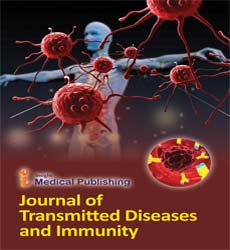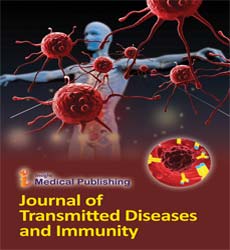ISSN : 2573-0320
Journal of Transmitted Diseases and Immunity
Role of Rapid Science Communication in Prevention and Control of Transmitted Diseases
Amjad Ali*
Center for Applied Molecular Biology(CAMB), University of the Punjab, Pakistan
- *Corresponding Author:
- Amjad Ali
Center for Applied Molecular Biology(CAMB), University of the Punjab, Pakistan.
E-mail: amjadali8328@gmail.com
Received Date: May 04, 2021; Accepted Date: May 11, 2021; Published Date: May 18, 2021
Citation: Ali A (2021) Role of Rapid Science Communication in Prevention and Control of Transmitted Diseases. J Transm Dis Immun. Vol.5 No.3:34
Transmitted diseases have been prevalent all across the world. There are several modes of disease transmission including person-to-person contact, infected biological origin droplet spread, contaminated objects, airborne transmission, contaminated food and drinking water, animal-to-person contact, or even an insect bite such as in the case of vector-borne disease. Medical science and technology have progressed a great deal and consequently, significant research efforts were made into evaluating the cause, devising prevention strategies, and treatment of several transmittable diseases. Identification and characterization of pathogenic microorganisms were also possible due to advancements in technology such as electron microscopy. Disinfection strategies have also progressed from mere traditional exposure to sunlight to artificial electromagnetic radiations such as microwave, ultraviolet light, and gamma irradiation. Effective chemical disinfectants have also been synthesized that interrupt the disease transmission cycle. Disease modeling and epidemiological studies have enabled greater control on disease prevention including timely vaccine development and immunization programs. However, infectious diseases are continuing to thrive, transmit, infect, and cause diseases even of pandemic proportions. The impact of communicable diseases particularly that of the COVID-19 pandemic is being felt severely all across the world.
Effective and rapid communication of scientific explorations, critical observations, and opinions are highly essential for restricting disease transmission, prevention, and elimination of communicable diseases. Ever since its establishment in the year 2017, the Journal of Transmitted Diseases and Immunity has played an important role in the dissemination of scientific knowledge on transmitted diseases. The journal has been consistently providing an essential overview of the transmitted diseases and immunology aspects of communicable diseases. The journal aims to provide the most comprehensive yet synoptic perspective of communicable diseases and associated immunology. The journal forms a reliable source of authoritative and up-to-date scholarly information on the current clinical and diagnostic practices including methodologies for the identification and control of transmitted diseases, their occurrence; mode of transmission, incubation period, susceptibility, and resistance. The journal offers coverage of the entire range of relevant topics from the basic principles of transmissible disease control to advanced innovations in treatment and healthcare. Novel insights are solicited on individual infectious diseases and the associated syndromes along with critical opinions on current strategiesand challenges for the treatment of various bacterial, fungal, parasitic, and viral infectious diseases particularly in developing and tropical countries.
The journal focuses on the National and International health care regulation about new, rare, and emerging infections including zika virus, Ebola, and other infections that have the potential to expand into a pandemic while emphasizing recent developments in both scientific and administrative fronts in the prevention of infectious diseases such as coronavirus (MERS and SARS).The journal caters to the new informational needs of public health practitioners, physicians, epidemiologists, nurses, pathologists, microbiologists, molecular biologists, immunologists, and evolutionary biologists. With in-depth coverage of the subject, this Journal not only bridges the gap between translatable knowledge and data on public health but also fulfills the knowledge requirements of medical students and public health schools all across the world. The journal is certainly an important knowledge resource and standard reference for health care professionals. The journal has been providing an open-access platform to the contributing authors for presenting their expert analysis on disease transmission, epidemiology, microbiology, pathogenesis, and various modern treatment options. Particular attention was also given to contemporary antibacterial and antifungal agents, their activity, efficacy, mode of action, limitations, and current challenges in drug-based therapy.
The journal invites manuscripts that report exploration of the medicinal chemistry, drug designing, and development of new antiviral agents, and also communications highlighting the latest vaccine and drug developments in the clinical management of viral diseases. Some of the important specific topics that the journal deals with include diseases such as leprosy, Buruliulcer, Trachoma, Anthrax, Brucellosis, Botulism, Dengue, Diphtheria, Chlamydia. Gonorrhea, Genital Herpes, Hepatitis, Malaria, Influenza, Pelvic Inflammatory Disease, Leprosy, HIV/AIDS, Human Papillomavirus (HPV), Syphilis. Bacterial Vaginosis, Trichomoniasis, Pneumococcal Disease, Tuberculosis, Yellow Fever, and Cholera; sub-cellular and molecular immunology, immunogenetics; imaging, mathematical modeling; microbiological culture, molecular pathogenesis, virulence, experimental models of infection and transmission; host resistance or susceptibility, and innate as well as adaptive immune responses. The journal invites contributions that provide a comprehensive and well-balanced overview of infectious diseases elaborating the mechanisms of the spread of the diseases and what potential measures can be taken to control the disease spread from vaccination to public health awareness. The study of the immune system and its potential to fight the infectious strains and its evolution is central to the development of vaccines and ultimately the control of the epidemic. The journal solicits expert opinions on immunology aspects of HIV, influenza, foot-andmouth disease that provide new insight into infectious agents, immunity, and the evolution of the infectious disease.
I here with thank the contributing authors, editors, and peer reviewers for their diligence and professional services in transforming the manuscripts into scientifically sound systematic presentations to meet the growing informational needs of the global health community engaged in fighting the transmitted diseases.

Open Access Journals
- Aquaculture & Veterinary Science
- Chemistry & Chemical Sciences
- Clinical Sciences
- Engineering
- General Science
- Genetics & Molecular Biology
- Health Care & Nursing
- Immunology & Microbiology
- Materials Science
- Mathematics & Physics
- Medical Sciences
- Neurology & Psychiatry
- Oncology & Cancer Science
- Pharmaceutical Sciences
